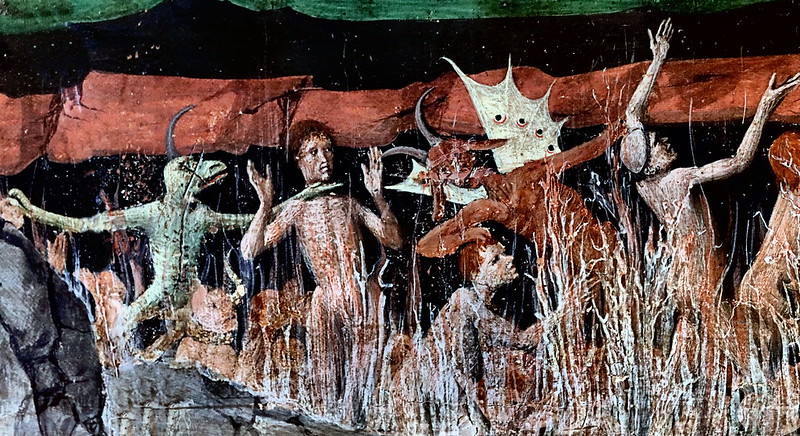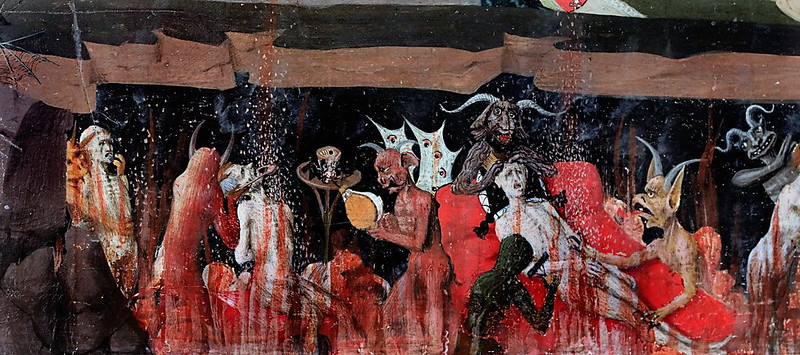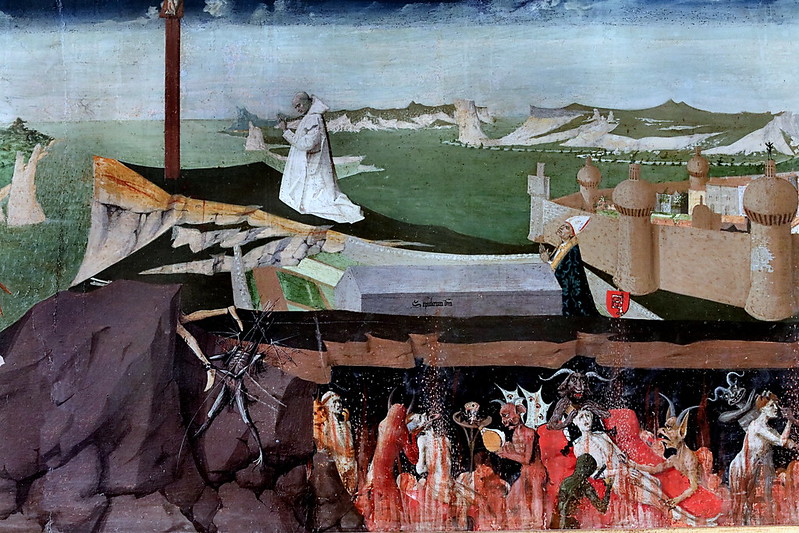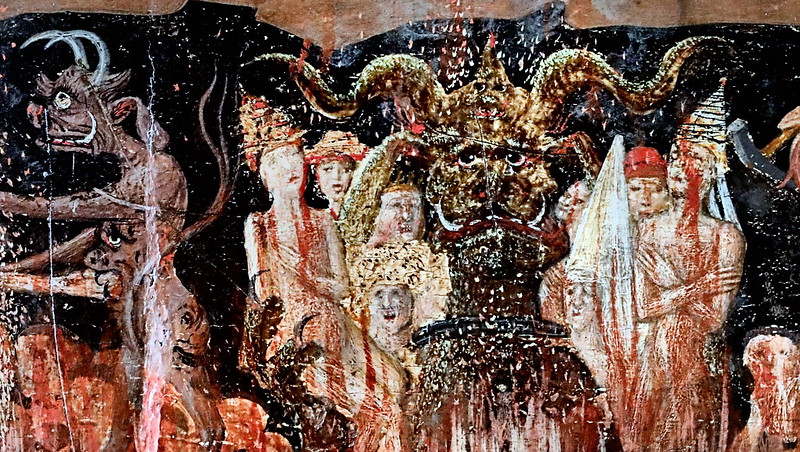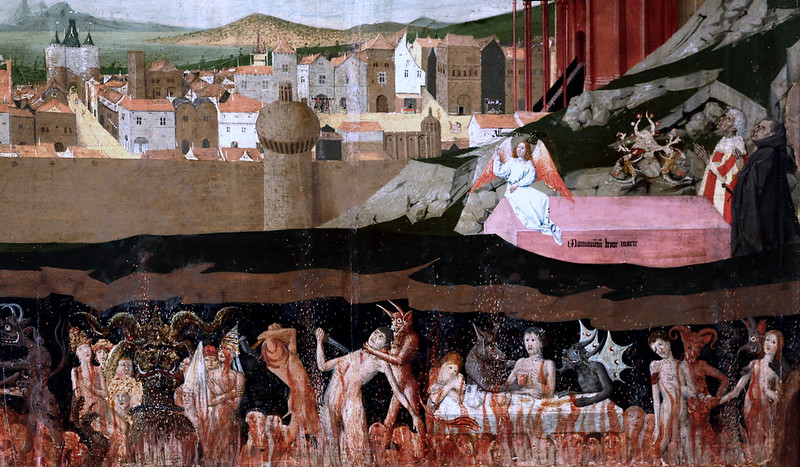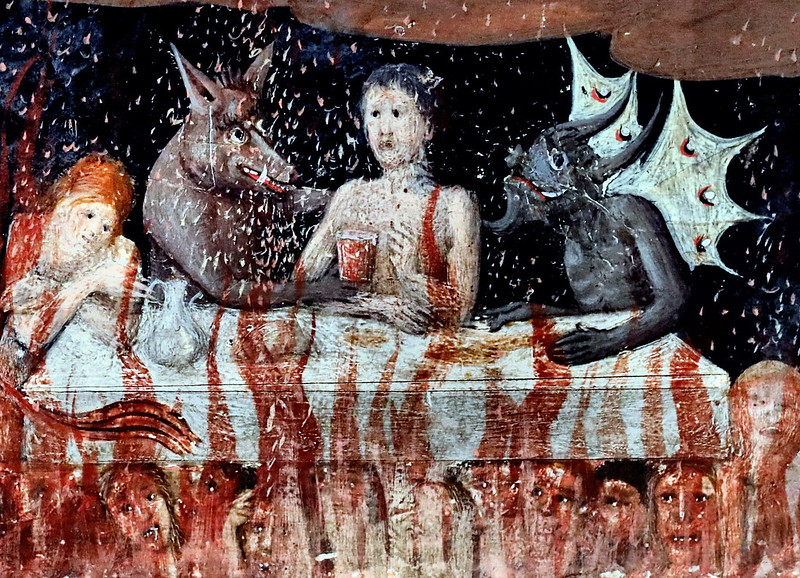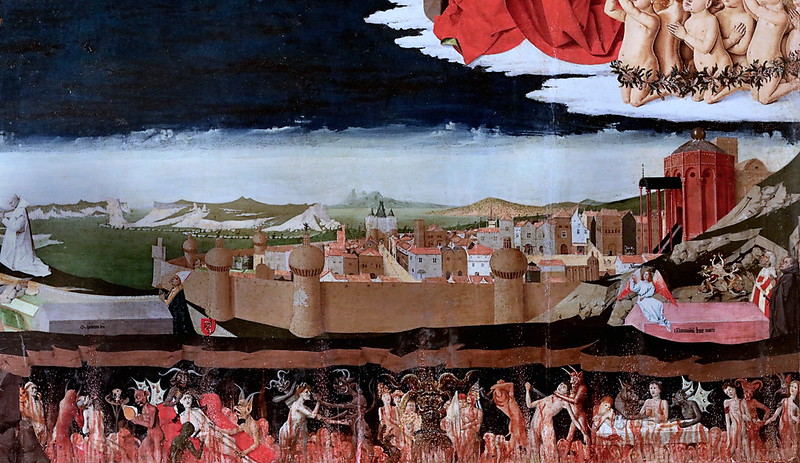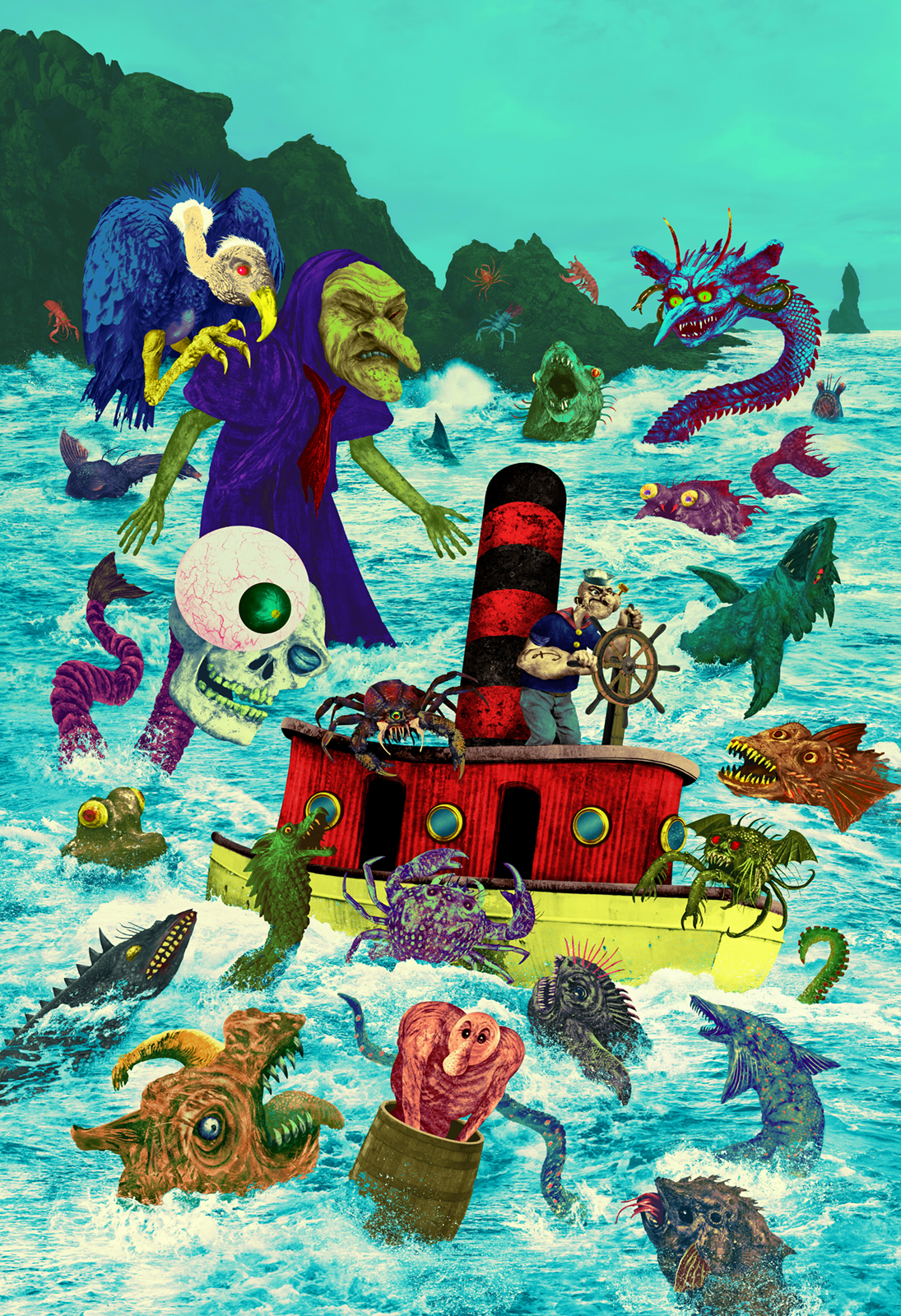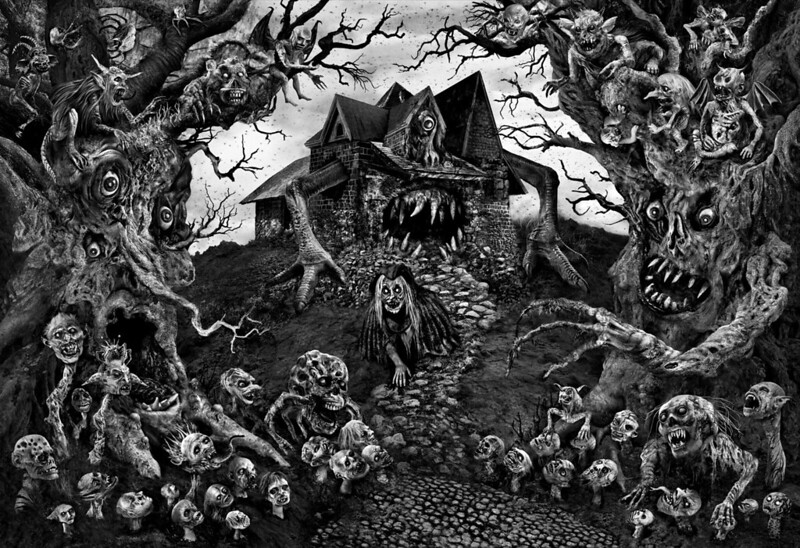Outsiders & Others
State of the Gallery: December 2021
Mail Call: Chris Perkins' "Advanced Dungeons & Dragons 3rd Edition"
Been a busy time at work, so just a fast one today.
Some time ago I grabbed something called "Advanced Dungeons & Dragons 3rd Edition" from the web. It has been sitting in my "to be sorted" folder for ages. I was in the process of digging up some other material for a project when I happened upon them. The layout was nice and clean and the covers were nearly print-ready. So I spent some time a few nights ago tweaking it and slapped the whole thing on Lulu.
Here is what I got.










Frankly, I am pretty happy with it.
I went a re-looked up what this game was/is and it turns out it was done by Chris Perkins. The game is a very nice blend of AD&D 1st and 2nd Editions with mechanics from D&D 3rd Edition and inspiration from Castles & Crusades. The overall effect is not unlike D&D 5th Edition, but more of a 1st Edition feel.
The art is all copied from published classic D&D sources, so there is no way this thing is legal to sell. I am sure if cleaned up it could be released under the OGL, but it is so close to Castles & Crusades and D&D 5th edition there is no need to do so save as an entertaining experiment.
Perkins used to have a website for it, http://www.adnd3egame.com/cnc.htm but it is long since gone. There are details about it at RPG Geek and Boardgame Geek. I have no idea where it is hosted anymore. I found a new site for it here: https://scruffygrognard.wordpress.com/2010/02/02/add-3rd-edition/. Note: Perkins is now working on a BX3e.
It is a completely playable game and has a lot of nice features. It reads like a D&D "Greatest hits" album. It is just missing some "kits" or "subclasses" to make it more like 5e.
The question of course is why play this when I have all the other versions of *D&D? Well, the simple answer is that it looks like fun. IT might be neat to play this "what if" version. It is also interesting to see which design choices Perkins went with. Like why 20th century D&D style saving throws and not say 3rd/4th Edition ones or 5th Edition/Castles & Crusades ones? How does the skill system work (feels like a mix of AD&D 1st ed and D&D 3rd ed)? There are Bard and Monk classes, how do they compare to their 1st and 3rd ed counterparts? Plus there is a section on Psionics. So there is a lot to explore here.
Besides the books are damn attractive. The layout like I said is clean and simple, but it appeals to me.
Now that I found his site again I am curious to see if there will be more updates on it. His BX3e project also looks very interesting.
Monstrous Monday: Demon Prince Orcus fo AD&D 2nd Edition
Going back a bit to do some more level setting and based on a conversation I had last week with a friend. He was looking for some stats for Orcus for 2nd Edition AD&D. I have stats for all versions of AD&D/D&D for him, but none for 2nd Ed. I had always felt that Orcus was dead throughout all of 2nd Edition (thanks to The Throne of Bloodstone) but the events of Dead Gods brought him back.
I did have some older AD&D 2nd Ed stats I had created in something I call the "Red Book." The notes are largely cribbed from 1st Edition sources.
To rebuild this I am going to also look to other sources like Swords & Wizardry and Pathfinder.

Orcus, Demon Prince of the Undead
Climate/Terrain: The Abyss
Frequency: Unique
Organization: Solitary
Activity Cycle: Any
Diet: Carnivore
Intelligence: Supra-genius (20)
Treasure: P, S, T, U
Alignment: Chaotic evil
No. Appearing: 1 (Unique)
Armor Class: -6
Movement: 18, Fl 36 (B)
Hit Dice: 25 (130 hp)
THAC0: 7
No. of Attacks: 3 (see below)
Damage/Attack: 1d10+3/1d10+3/2d4 + special
Special Attacks: Fear, spell-like powers, summon and command undead, Wand of Orcus
Special Defenses: +3 or better weapons to hit
Magic Resistance: 85%
Size: L (15' tall)
Morale: Fearless (19-20)
XP Value: 36,000
Orcus is the Prince of the Undead, and it said that he alone created the first undead that walked the worlds.
Orcus is one of the strongest (if not the strongest) and most powerful of all demon lords. He fights a never-ending war against rival demon princes that spans several Abyssal layers. From his great bone palace he commands his troops as they wage war across the smoldering and stinking planes of the Abyss. Orcus spends most of his days in his palace, rarely leaving its confines unless he decides to leads his troops into battle (which has happened on more than one occasion). Most of the time though, he is content to let his generals and commanders lead the battles.
Appearance: Orcus is a grossly fat demon lord, some 15 feet tall. His huge grey body is covered with coarse goatish hair. His head is goat-like, although his horns are similar to those of a ram. His great legs are also goat-like but his arms are humanoid. Vast bat wings sprout from his back, but these are usually tucked out of sight when he is not in flight. His long, snaky tail is tipped his a poisonous head.
Combat: It is probable that this creature is one of the most powerful and strongest of all demons. If he so much as slaps with his open hand the blow causes 1-4 hit points of damage. His terrible fists can deliver blows of 3-13 hit points. If he uses a weapon he strikes with a bonus of +6 to hit and +8 on damage. Additionally, his tail has a virulent poison sting (-4 on all saving throws against its poison), and his tail strikes with a 15 dexterity which does 2-8 hit points each time it hits.
Orcus prefers to fight using his wand. (see below)
Orcus radiates a 60-foot-radius aura of fear (as the spell). A creature in the area must succeed on a saving throw vs. Spell or be affected as though by a fear spell (caster level 30th). A creature that successfully saves cannot be affected again by Orcus’s fear aura for one day.
Orcus can, at will, use any one of the following powers:
Orcus can command or banish undead as a 15th-level cleric, controlling up to 150 HD worth of undead at one time. He casts spells as a 15th level cleric and 12th level magic-user, and can use the following magical abilities at will: animate dead, charm monster, darkness, dispel magic, ESP, fear, feeblemind (1/day), lightning bolt (12 die), speak with dead (as 20th level cleric), symbol (any) and wall of fire.
Additionally, he has an 80% chance of gating in any demon of type I-V (but only a 50% chance of gating a type VI or VI and will never call upon another prince).Orcus furthermore is able to summon the undead, for he is their prince. If random calling is desired by the referee the following is suggested:
- 4-48 Skeletons
- 4-32 Zombies
- 4-24 Shadows
- 2-8 Vampires
Habitat/Society: When not warring against rival demon princes, Orcus likes to travel the planes, particularly the Material Plane. Should a foolish spellcaster open a gate and speak his name, he is more than likely going to hear the call and step through to the Material Plane. What happens to the spellcaster that called him usually depends on the reason for the summons and the power of the spellcaster. Extremely powerful spellcasters are usually slain after a while and turned into undead soldiers or generals in his armies.
He has a following of human worshippers as well; warlocks, death masters, necromancers, and evil priests.Ecology: Orcus controls several levels of the Abyss he claims as his own including the 113th and 333rd layers. When not at war with the forces of good and life he wars with all the other demon princes for control of all the Abyss. Orcus' goal is to see all life extinguished and death reigns supreme.

Wand of Orcus: Mighty Orcus wields a huge black skull-tipped rod that functions as a +3 heavy mace. It slays any living creature it touches if the target fails a saving throw. Orcus can shut this ability off so as to allow his wand to pass into the Material Plane, usually into the hands of one of his servants. Further, the Wand has the following magical powers: 3/day—animate dead, darkness and fear; 2/day—unholy word.
--
Might need to tweak it some for my own uses, but this looks like it works well enough. These stats are not perfect by any stretch, but they feel pretty close.
I reject the fan theory that so many have adopted that Orcus was once human. Though this does fit in with the Mystara/BECMI Immortals Set version of Orcus. Though THAT Orcus also has 39 HD and 620 HP.
I prefer my own where he is a remnant of a former god. He has memories of God-like power, but nothing else. After all according to Milton Orcus was in Hell when the Devils first arrived.
In any case, I do see that Orcus became more powerful after the events of Dead Gods. Maybe also explaining why he went from being "immensely fat and covered in grey hair" to the red demon of 21st century D&D.
Links
[Free RPG Day 2021] Victoriana: Going Underground
—oOo—
Cubicle7 Entertainment Ltd. offered two titles for Free RPG Day 2021. One is Reap and Sow, a scenario and quick-start for Warhammer Age of Sigmar Soulbound. The other is Going Underground, an adventure for the forthcoming version of Victoriana, the roleplaying game of intrigue, sorcery, and steam for Dungeons & Dragons, Fifth Edition. This is the roleplaying game of gothic fantasy magic and steampunk engineering set at the height of the reign of Queen Victoria and the British Empire. Magic is commonplace and even powers many of the new technological advances, such as the clockwork automata and prosthetic limbs, the latter often replacing those lost through industrial accidents or war. However, there is tension between maintaining the old ways of magic and embracing the optimism which comes with the new technology and the speed of change. The world of Victorianais also inhabited by different species too. The Duine are much like Humanity, but there are also Púca—humans with animal traits; Muirlochs—nocturnal Humans with batlike ears and an affinity for technology; Khald—short, stout, and stubborn professionals known for their craftsmanship; Gruagach—tall, muscled, and honestly direct of opinion; and Elderen—elegant psychics said to have connections to the fae. There are numerous sources of magic too. These include the Aluminat faith which the Luminous Host and works to keep Humanity from becoming embroiled in the dangers of Entropy—which is thought to have lead to the apocalyptic magical event known as the Great Cataclysm in the past; the Thaumturge’s Guild which has legitimised and industrialised magic; Animism is drawn from the Otherworld which is home to the fae and harnesses the quintessence of nature to create talismans; and Maleficium is dark magic—necromancy and diabolism—taught by the Pallid Ones, fallen Archons. Magic is also another source of tension since it was once the sole purview of the nobility, but this is no longer the case as it has been industrialised and democratised.
Victoriana: Going Underground is a preview of the forthcoming new edition of Victoriana, effectively the fourth edition, which is designed for use with Dungeons & Dragons, Fifth Edition. It moves the setting on two decades from just after the Crimean War to the Queen’s Golden Jubilee in 1877. After a solid introduction which explains the setting, it quickly throws both players and Game Master into the adventure itself, ‘Going Underground’. Designed for four players—the quick-start includes four pre-generated Player Characters—it is a short, direct, and linear adventure. They include Adelaide Finch, a Muirloch Sleuth, Theodore Gatesly, a Noble Gruagach Confidante, Sam Urmacher, a Púca gadgeteer, and Charalata Rathmore, an Elderen Animist. Each of the four comes with a full colour portrait and a clearly presented set of stats and abilities. All four are attending the opening and inaugural running of the deepest and newest underground train line built and run by the City & South London Subway. As detailed in the opening explanation for the players and their characters, Adelaide Finch has learned that someone is planning to sabotage the opening of the line, Theodore Gatesly used his connections to get the quartet tickets to the event, Sam Urmacher is along to investigate and write an article for periodical about trains, and Charalata Rathmore may help soothe the proletariat’s objections to the newly dug line.
The adventure itself is direct. The Player Characters alight from their carriage, descend into the London Underground, interact with the other guests and the staff, before boarding the train, and making the journey from Cannon Street to Stockwell and back (the alternate history of Victoriana means that the two are connected via the same line, when at the time they would have completely separate, unconnected lines). On the way something strange happens and it appears to be pulling the train through a portal. The question is, what caused this, and how do the Player Characters and everyone aboard the tube train get back? Throughout there are moments when the adventure puts each of the Player Characters in the spotlight, mostly to learn new information rather than act, and it is not until the strange event occurs that they really have the chance to do anything and be more proactive. Up until this point it does feel as if the Player Characters are in the background of the adventure, often reacting to the sometimes-clichéd actions and utterances of the NPCs. Once the train is thrown into the portal, the Player Characters have more opportunities to act—mostly combat and making repairs, but definitely more than the initial parts of the adventure.
Mechanically, there are relatively few changes between Victoriana and Dungeons & Dragons, Fifth Edition—at least in Victoriana: Going Underground. The most notable is the list changes to various skills, of which the Social Class skill, with its specialisations of Noble, Bourgeoisie, and Proletariat, figure prominently in the play of the scenario. The other is the addition of Quintessence, which is used to power spells, special abilities, and devices. This replaces the traditional Vancian spell slots of Dungeons & Dragons with what is in effect, a spell point system.
Physically, Victoriana: Going Underground is decently presented and written, with decent artwork—especially those of the Player Characters. It is a pity that none of the NPCs are illustrated.
Victoriana: Going Underground is short and direct and playable in a single session. As an example adventure, it is not that engaging, often relying upon clichés for its presentation of its NPCs and having a tightly plotted script. The latter though, is primarily due to the length of the scenario—a little over six pages in a fourteen-page booklet—and the fact that it is set in a tube train! Nevertheless, there are opportunities for the Player Characters to interact with the NPCs, shine a little, and the scenario does go out of its way to spotlight each of the four pre-generated Player Characters, and there is also scope for players to roleplay as well. However, as an introduction to the new edition of Victoriana, the scenario in Victoriana: Going Underground is too limited and too linear—certainly to stand on its own as a memorable adventure. As the opening chapter or prequel to a fuller, deeper, and proper scenario, Victoriana: Going Underground is serviceable enough, but not much more.
The Aftermath: Nightmare Weekends Before Christmas 2021 #1
Hexagonal Horror
Best Left Buried is a fantasy horror roleplaying game in which characters venture into the crypts and caves below the earth in search of secrets and treasures and there face unnameable monsters, weird environments, eldritch magic, and more… Whilst deep underground, they will be under constant stress, face fears hitherto unknown, and the likelihood is that they will return from the depths physically and mentally scarred, the strangeness they have seen and the wounds they have suffered separating them from those not so foolish as to descend into the dark. Published by Soul Muppet Publishing, one of the more accessible versions of the roleplaying game is Best Left Buried: The ZiniEdition or A Doom to Speak – The Crypt Collection 1: Rules because it presents its contents in discrete, self-contained chapters or ‘Zinis’. This includes an anthology too of fifteen mini-dungeons and mini-locales reduced to the ‘Zini’ format, just four pages per entry, many of which can be found in this A Doom To Speak Megabundle.
Released at DragonMeet 2021, A Garden Most Foul: A rot-choked fever-nightmare adventure for Best Left Buriedis the newest zini, another four-page pamphlet scenario. This takes the Player Characters into the Garden of the Demon Postulix, deep in the wilderness, part of an expedition led by Lord Amador Gregory to discover the Tree of Life and its miraculous fruit. It begins with the Player Characters, having been told that the Demon Postulix grants eternal life, standing at the entrance to a low tunnel which runs through the high hedge of thick thorns surrounding the garden. The inside consists of a mini-hexcrawl of a single hex containing seven smaller hexes. The terrain under foot and the general conditions is mostly foul—as the title promises—ranging from thick, boot-sucking mud to fields of jagged boulders which almost seem to want to bite passers-by. In between are landscapes which resemble acres of rolling slabs of muscle and fat, copses of trees from which hang strange pods, a fungus infested cave, abscesses containing hives of rotten insects, and freshly tilled fields sown with fragments of bone…
A Garden Most Foul is a relatively light mini-adventure and there is a sparseness to it—no surprise given its length. Nevertheless, it possesses a weird and disturbing atmosphere, which comes of its disparately themed hexes being mashed up against each other. The location is also sparsely populated, with just the one NPC, two singular monsters, and the one monster type. There is room too for the Game Master to expand the fungus infested cave, perhaps connecting it into any one of the fungal-themed and Mushroom Men populated adventures written for the Old School Renaissance. There are moments too when the Cryptdiggers will find themselves being hunted, likely leading to clash between a great abomination and the unwholesome beast it rides. The story though suffers from a paucity of plot and what there is perhaps a little too obvious. Plus the personalities involved are underwritten. On the plus side, this does mean that there is plenty of scope in the zini for the Game Master to expand and develop A Garden Most Foul where necessary, whether that is expanding the plot or adding an NPC or two—with there being room aplenty for both.
Physically, A Garden Most Foul is also fairly unpossessing. The only illustration is on the front cover and is that of the two singular monsters—an abomination and the beast it rides. It nicely captures the utterly unwholesome nature of both. The zini is well written and easy to grasp, so that the Game Master could prepare with very minimal preparation.
A Garden Most Foul is short, weird, and self-contained. All features which make it easy to run, with very little preparation time—though perhaps in terms of plot and personalities, if the Game Master has some time, then she should develop both. The minimal preparation time and the self-contained nature means that for Best Left Buried, it is incredibly easy to pick up and get to the table. It also means that it is easily dropped into any distant wilderness location and it can be just as easily adapted to the fantasy roleplaying game of the Game Master’s choice, especially ones which embrace the weird and the horrifying—for example, Warhammer Fantasy Roleplay or Shadow of the Demon Lord. Simple and sparse, A Garden Most Foul: A rot-choked fever-nightmare adventure for Best Left Buried is ready to fill in a space when the Game Master needs it, or waiting for development to bring out little more personality and plot.
Bearfaced Horror
 For fans of Vaesen – Nordic Horror Roleplaying, the roleplaying game of investigative folklore horror set in nineteenth century Scandinavia, based on Vaesen: Spirits and Monsters of Scandinavian Folklore as collected and illustrated by Johan Egerkrans, there is just the one supplement supporting it—for the moment. However, for Vaesen and other titles from Free League Publishing, there is the Free League Workshop. Much like the DM’s Guild for Dungeons & Dragons, this is a platform for creators to publish and distribute their own original content, which means that they also have a space to showcase their creativity and their inventiveness, to do something different, but ultimately provide something which the Game Master can bring to the table and engage her players with. Such is the case with Unbearable.
For fans of Vaesen – Nordic Horror Roleplaying, the roleplaying game of investigative folklore horror set in nineteenth century Scandinavia, based on Vaesen: Spirits and Monsters of Scandinavian Folklore as collected and illustrated by Johan Egerkrans, there is just the one supplement supporting it—for the moment. However, for Vaesen and other titles from Free League Publishing, there is the Free League Workshop. Much like the DM’s Guild for Dungeons & Dragons, this is a platform for creators to publish and distribute their own original content, which means that they also have a space to showcase their creativity and their inventiveness, to do something different, but ultimately provide something which the Game Master can bring to the table and engage her players with. Such is the case with Unbearable.Unbearable is written by one half of the hosts of the podcast, What Would Smart Party Do?—the other half designed King of Dungeons and presents an engaging and entertaining mystery with lots of Mats and puppies, plus a dilemma or two. It could easily be played in a single session, perhaps two at most, and would make a good option for a convention scenario just as it would for the Game Master’s own campaign.
In Vasen, the Player Chaarcters are members of the Society, which is based in Castle Gyllencreutz in the city of Upsala and which is dedicated to the study and understanding of the vaesen. Thus its members look for opportunities to investigative signs of Vaesen activity and so at the start of Unbearable, they find an interesting article in an issue of Fortean Times. This is a report about Alsen, described as the unluckiest village in Sweden, having recently been beset by a rash of inexplicable events. These include bear attacks, mystery fires, and disappearances to the point that it has gained a certain notoriety amongst tourists looking for a different sort of attraction. Notably though, the journalist for the Fortean Times who was reporting on the village has also gone missing. For the members of the Society, the question is, what exactly going on in Alsen and where is the missing journalist?
Unbearable is a classic ‘village in peril’ scenario and as such brings together some of its classic clichés. Thus we have a gossipy innkeeper’s wife who leaves him to do all the work, a drunken priest who is losing his faith and does not understand what is going on, and a useless mayoral figure, and nature itself which seems to be attacking anyone and everyone in Alsen, let alone the village itself. However, just because the scenario has an almost identikit structure, it does not mean that it is either a bad scenario or a poorly put together scenario. In fact, it is really quite an enjoyable scenario, with the Player Characters having to sort through or interact with the clichés in order to get to the truth of the matter—and the Game Master hamming up the old standards for she is worth! However, there is more to Unbearable than that, and diligent investigation will reward the Player Characters with a wealth of clues as to just not what is going on, but also how to stop it. This includes a great scene involving one or more Player Characters having to work the smithy at midnight under very ghostly light and all of them getting to the home of the local bear trapper who happens to have set all his traps out roundabout. All this is against a background of growing strangeness—fungus blooming the wooden foundations of buildings, bear attacks, wooden objects throughout the village sprouting leaves, the local vicar going off in a drunken fury, and more.
Ultimately, the Player Characters will have a showdown with the supernatural cause of the problems and deaths in Alsen, hopefully having gained an advantage or two from their enquiries in the village. The primary one presented in Unbearable is physical, and although options are discussed, the emphasis is firmly on the physical resolution. The options discussed cover more peaceful means of solving the scenario, but they are not explored in terms of game play, and that is a shame. The reasoning here is that the inhabitants of Alsen are going to want an end to the situation in the village and direct confrontation is the obvious means of achieving that, and it is a perfectly understandable motivation. However, players being players, they may not necessarily want to resort to a combative resolution, and so a more detailed discussion of the other options would have been useful for the Game Master.
Physically, Unbearable is cleanly laid out and easy to read. It comes with maps of Alsen and the surround area, as well as floor plans of the inn and the article from the Fortean Times as a handout. Both maps and handout are decently done. Also well done are the thumbnail portraits for the scenario’s eleven NPCs, such that it is a pity that the PDF does not come with a sheet with their names and portraits to show to the players. The artwork is also very nicely done and chosen.
There is a lot to recommend Unbearable. It is nicely presented, accessible, and self-contained scenario with a decent nature versus man plot and plenty of NPCs to interact with and clues to find. It is also easy to move to another location—though that location should have bears!—and easy to add to an ongoing campaign. Unfortunately, the lack of detail for other options for resolving the situation in Alsen means that it cannot be described as unbearably good. Which is disappointing, because if it did support those options it would have been worthy of that terrible pun. Nevertheless, Unbearable is solid scenario, offering a good mix of investigation and action.
Have a Safe Weekend
Dee's Occult Half-Dozen
 The Dee Sanction Adventures: A True & Faithful Transcription of Matters Concerning Lost Books, Strange Sorceries, Befouled Poppets, Accusations of Witchcraft, and Assorted HELLSCAPES is an anthology of adventures for The Dee Sanction, the roleplaying game of ‘Covert Enochian Intelligence’ in which the Player Characters—or Agents of Dee—are drawn into adventures in magick and politics across supernatural Tudor Europe. It collects a half-dozen adventures released as PDF titles for the original Kickstarter and subsequently funded by a second Kickstarter campaign for a print edition. All of these scenarios are set during the reign of Elizabeth I, beginning in the year 1570, when Pope Pius V excommunicates her for her heresy and her persecution of the Catholics In England and the Catholic conspiracies against her seem to run rampant. All six can be run in more or less any order, or alternatively, run as a six-part campaign. The Dee Sanction Adventures starts with advice to that end, but nevertheless, it does require some effort upon the part of the Game Master to make the connections and links between them and so have them form a whole campaign.
The Dee Sanction Adventures: A True & Faithful Transcription of Matters Concerning Lost Books, Strange Sorceries, Befouled Poppets, Accusations of Witchcraft, and Assorted HELLSCAPES is an anthology of adventures for The Dee Sanction, the roleplaying game of ‘Covert Enochian Intelligence’ in which the Player Characters—or Agents of Dee—are drawn into adventures in magick and politics across supernatural Tudor Europe. It collects a half-dozen adventures released as PDF titles for the original Kickstarter and subsequently funded by a second Kickstarter campaign for a print edition. All of these scenarios are set during the reign of Elizabeth I, beginning in the year 1570, when Pope Pius V excommunicates her for her heresy and her persecution of the Catholics In England and the Catholic conspiracies against her seem to run rampant. All six can be run in more or less any order, or alternatively, run as a six-part campaign. The Dee Sanction Adventures starts with advice to that end, but nevertheless, it does require some effort upon the part of the Game Master to make the connections and links between them and so have them form a whole campaign.The anthology—and potentially the campaign—opens with ‘Window of the Soul’ and the agents out on the town for an evening’s entertainment in the drinking holes, brothels, and bear-baiting pits of Southwark. However, their revelries are interrupted when they come upon a cart driver, his wife, and their child under assault by a group of ruffians, hellbent on doing them harm. This could be a simple robbery, but they detect something arcane about the attackers. Are they cursed? Bewitched? Or something else? Clues lead them into the comings and doings of Southwark and ultimately to the highest echelons the conspiracy against good Queen Bess. This is solid start to the anthology with a strange piece of investigation and incidences of mania which seem to affect the Londoners and the Player Characters.
It is followed by ‘The Gong Scourer’s Baby’ in which Doctor Dee—or Mister Garland—asks his Agents to investigate the birth of a Miracle Baby to a Gong Farmer in Southwark. With both the Queen and Doctor Dee away for her health, the Agents make the strange discovery that there is something more to the baby than mere miracle. Tracking down the source of the child will take them along the Thames and into a maze of industry and perhaps hints as to a conspiracy against Her Majesty. ‘The Gong Scourer’s Baby’ requires some input upon the part of the Game Master to set up and a bit more complex, with multiple options to choose from and timeline which the Player Characters will initially be unaware of.
The set-up to the third scenario harks back to the Player Characters’ own recruitment working as Agents for Doctor Dee. ‘In Fertile Soil’ takes the Agents out of London to investigate a possible Witch—accused of witchcraft and murder, and perhaps recruit her as a fellow member of the Sanction (and if not that, then help administer justice). The village of Soulgrave is a hotbed of gossip, and hides plenty of secrets, all under the eye of a puritanical parson. There is potential here for one or two creepy encounters out in the woods, and for Game Master an intriguing nod to future history and perhaps a roleplaying game like the FLAMES OF FREEDOM Grim & Perilous RPG.
A larger, more obvious monstrous threat has been harrowing travellers passing through Waltham Forest and so represents a potential threat to one of the Queen’s favourite hunting grounds, which means it requires urgent investigation upon the part of the Agents. After all, who would want to arouse the ire of the Queen? In ‘In The Monk’s Cowl’, the Agents are again sent out of London, this time to the market town of Waltham Abbey where they discover strange activities around the ruins of the abbey. This is perhaps the most complex investigation in the anthology, mixed in with some Hammer Horror, with no quite clear path to finding a solution to the problem and potential for disaster.
‘The Harrowing of Harlow Hall’ is a bit of an oddity in The Dee Sanction Adventures. It is a single location of adventure, set within the grounds and rooms of Harlow Hall, the home to one of the few individuals to have earned his freedom from the Dee Sanction. Thus it feels much more like a dungeon than any other adventure. It is also a much darker adventure in terms of its tone and content, and so does come with a warning for its horrifying content. It feels initially little like Hammer Horror film, but ramps up the nastiness as the Agents explore the house. ‘The Harrowing of Harlow Hall’ comes fifth in the anthology, but could easily be shifted to earlier or later if The Dee Sanction Adventures are being run as a campaign. However, its darker, perhaps even apocalyptically oppressive atmosphere means it is better suited for later in the campaign, and even perhaps as the climax to such a campaign.
Lastly, the feel of the dungeon continues in ‘Ex Libris’, which takes place in Deptford village where Doctor Dee sends the Agents to recover a copy of The Book of Dead Names. However, as they investigate the house and its cellars, the Agents discover that they are not the only ones after the book. This sets up a direct confrontation with the cultists and adds an element of time to the scenario as the Agents and their adversaries race to find the book. Plus, depending upon when the Game Master runs the scenario, it can lead into further adventures if the Agents fail to obtain the book—which is a serious possibility.
Physically, The Dee Adventures is a short, full colour digest book. The anthology is well written and benefits from some decent handouts and maps. The artwork is variable in quality, at best decent rather than outstanding. All of the adventures are quite short and should take no more than two or three sessions to play through—some much shorter than that.
The Dee Sanction Adventures: A True & Faithful Transcription of Matters Concerning Lost Books, Strange Sorceries, Befouled Poppets, Accusations of Witchcraft, and Assorted HELLSCAPES delivers on all that its title states. This is a solid and diverse collection of adventures that will see the Agents of Dee facing a variety of threats and dangers, whether used separately, together as a campaign, or woven into the Game Master’s own campaign.
The Aftermath: Blood Over Texas Horror for the Holidays 7 – 4
Alimentary Now
 There is no dungeon as queasy, bilious, or tumorous than Genial Jack Vol. 2. It also throws in swollen tongued pestiferous thrushspawn, toxically affectionate amoeboids, a true vampire squid, and Dog-Nymph Skulla, the Swallowed Sea-Devil, along with Gutreavers, Tapeworm swarms, shivers of Septic Sharks, lost and swallowed cities, wrecks aplenty, and more—all in the longest, most linear dungeon possible and all in the strangest location possible. The location is ‘Genial Jack’, the Godwhale, a levianthine Blue Whale which for centuries has been home to the teeming town of Jackburg built across his thick skin and in his stomachs and deep into his intestines, much of it made up of the ships he has swallowed and those that have sailed into his maw and permanently moored inside of him. Jackburg is home to peoples and islands that the whale—the ‘Genial Jack’ of the title—has swallowed, from the Draugr to the Fomorians, and today it serves as a roaming free port, from which merchants sell the strange and exotic goods they have acquired in distant lands as well as the ambergris constantly formed deep in his gut. Yet beyond—or rather behind—the public spaces of Jackburg, lie ancient wonders of swollen cities and partially digested Jackburgs past, the Ambergris Consortia and its tight control of perhaps the most precious substance found within the Godwhale, Gutreavers ready to attack vessels travelling deep into Genial Jack—plundering cargo and enslaving passengers and crew, and a refuge for its outcasts, such as criminals who have fled the reach of the Whaleguard and Jacksblood-Addicts who find a way to slice at the intestinal walls and feed their addiction to the whale’s blood. All this whilst the Gutgardeners, combining druidic magic and ancient technoscience, labour to keep Genial Jack’s digestive microbiome as healthy as they can. Essentially, in presenting the ‘Entrails’, Genial Jack Vol. 2explores the Godwhale’s outback and hinterland...
There is no dungeon as queasy, bilious, or tumorous than Genial Jack Vol. 2. It also throws in swollen tongued pestiferous thrushspawn, toxically affectionate amoeboids, a true vampire squid, and Dog-Nymph Skulla, the Swallowed Sea-Devil, along with Gutreavers, Tapeworm swarms, shivers of Septic Sharks, lost and swallowed cities, wrecks aplenty, and more—all in the longest, most linear dungeon possible and all in the strangest location possible. The location is ‘Genial Jack’, the Godwhale, a levianthine Blue Whale which for centuries has been home to the teeming town of Jackburg built across his thick skin and in his stomachs and deep into his intestines, much of it made up of the ships he has swallowed and those that have sailed into his maw and permanently moored inside of him. Jackburg is home to peoples and islands that the whale—the ‘Genial Jack’ of the title—has swallowed, from the Draugr to the Fomorians, and today it serves as a roaming free port, from which merchants sell the strange and exotic goods they have acquired in distant lands as well as the ambergris constantly formed deep in his gut. Yet beyond—or rather behind—the public spaces of Jackburg, lie ancient wonders of swollen cities and partially digested Jackburgs past, the Ambergris Consortia and its tight control of perhaps the most precious substance found within the Godwhale, Gutreavers ready to attack vessels travelling deep into Genial Jack—plundering cargo and enslaving passengers and crew, and a refuge for its outcasts, such as criminals who have fled the reach of the Whaleguard and Jacksblood-Addicts who find a way to slice at the intestinal walls and feed their addiction to the whale’s blood. All this whilst the Gutgardeners, combining druidic magic and ancient technoscience, labour to keep Genial Jack’s digestive microbiome as healthy as they can. Essentially, in presenting the ‘Entrails’, Genial Jack Vol. 2explores the Godwhale’s outback and hinterland... Genial Jack Vol. 2, published by Lost Pages, continues the description of the Godwhale begun in Genial Jack Vol. I, a serialised setting of nautical weirdness and whimsy written for use with Dungeons & Dragons, Fifth Edition, but with an Old School Renaissance sensibility and tone combined with elements of steampunk and grotpunk. Where the first issue introduced the setting of the Godwhale from its city of Jackburg to The Gutgardens at the bottom of the whale’s main stomach, and its varied inhabitants such as the drowned Draugar, the shapeshifting Finfolk, the crafters that are the Formorians, Jackburg’s literal underclass the Urchins, the mercantile Octopoids, the vicious shark-men Selachians, and more.
Genial Jack Vol. 2 begins with reasons for entering the Entrails—Jackburg University being willing to pay for artifacts found there, mounting an ambergris mining expedition, investigating the loss of workers for the Ambergris Consortia, collecting a bounty on Ericius, the Urchin assassin, and more. The Dungeon Master can easily mix and match—or mismatch—these or keep them separate to provide motivations for multiple expeditions into the back end of the Godwhale. Since the Player Characters will be mounting an expedition, they will need equipment, so the next stop is shopping, and so a fully illustrated list of items particular to expeditions into the Entrails is also given, like the Fumehound, a tiny dog with a superb sense of smell which will bark in the presence of ambergris, or Anglerfish Lanterns, consisting of glass globes containing an ugly fish which will provide a light if fed. The circle of Guntgardeners is also described, an alternative organisation of Druids dedicated keeping the Godwhale’s guts contracting and relaxing, along with its commonly taught spells. Then the natural perils of the Entrails are detailed—the stench, the slipperiness, miasmas, and a whole lot more. Make no mistake, the Entrails are literally a stomach churning, pulsating, pustulent environment and not for the faint hearted.
As well as a decent table of random encounters, Genial Jack Vol. 2 details some fourteen magical items and artifacts to be found in the Entrails, many of which form the basis of quests and sidequests once the Player Characters have begun interacting with the denizens of Genial Jack’s bowels. Some of them are highly entertaining, such as the skulk-marked Thanometer or Scavenger’s Compass, which detects the nearest dead humanoid; The Rude Shield, which has leering grotesque features and maintains an insulting running commentary on anything and everything it sees, and whilst it hinders attempts at stealth, it can cast Vicious Mockery; and The Bristling Blade, a boar-headed heavy scimitar which inflicts savage wounds out of which sprouts greasy bristles!
And then it is into the Entrails themselves, a tangled, colonic mass of the Small Intestine and the Large Intestine separated by Herniaheim. From the Duodenum Docks, the Player Characters will set out on a journey into darkness, their senses assaulted by musky, feculent, effluent, rotten, acrid, and bilious smells, and queasy sucking, whispering, rustling, and susurrating sounds. Every location begins by telling the Dungeon Master what her players can see, smell, and hear before presenting the people to be found and the perils faced. So at the Filthfalls, the Player Characters will hear the rushing sound of debris and effluence, smell a combination of raw sewage, rotten fish, and ripe flesh, and whilst they will not encounter anyone, the Player Characters must work to avoid the foul falls, though if they can lower themselves into the pool below, they may find some plunder! Halfway down, they will find Hernaheim, a protrusion of the intestinal walls in which sits a cannibal fortess-town, ruled over the for the moment, by the Corsair Queen, Amaranth ‘Falsebeard’ Leech’, until such times as she is killed a pretender to the throne in the annual battle to the death in the Orifice. This is a fighting pit with a central pool filled with septic sharks and other intestinal creatures, which can be crossed using the flimsy rope bridges. In Hernaheim, septic sharks are farmed for food by Canness Sharpnose and her heretical order of Sawtail Nuns dedicated to the Sharkfather, all manner of ghastly fun can be found in Slimeside, Hernaheim’s ‘oozing’ pleasure district, and a previous version of Jackburg, long swallowed by Genial Jack hides secrets amidst its infestation of Jacksblood addicts.
Beyond Hernaheim stretches the Large Intestine, home to a Narwhal Skeleton, the Swallowed Sea-Devil Shrine, and the Elder Ruins. These are perhaps the final destinations for any venture this far deep into Genial Jack, and will likely require the Player Characters to have made multiple journeys into the depths. Many of the locations come with encounters and NPCs which will often spur the Player Characters to travel further. This is all backed up with a Colonic Bestiary containing sixteen entries, like the Corsair Queen, Gutreavers, Jacksblood-Addicts, Septic Sharks, Skulla, the Swallowed Sea-Devil, and even a True Vampire Squid, the latter of which takes a two whole pages!
Physically, Genial Jack Vol. 2 is a content-packed, well-written A5-sized fanzine style publication. The dungeon is fantastically illustrated and mapped out in thematically squidgy and convoluted detail.
Unfortunately, Genial Jack Vol. 2 has a problem—or rather a perceived problems, and this is that the fact that it is written for use with Dungeons & Dragons, Fifth Edition. Which is not to everyone’s taste and further, they may reject Genial Jack Vol. 2 out of hand because of it. Now not only is that their problem rather than one with Genial Jack Vol. 2, but they would also be completely and utterly in the wrong and it would be their complete and utter loss were they to do so. Whether or not you dislike Dungeons & Dragons, Fifth Edition, the fact is, the tone and style of Genial Jack Vol. 2 is such that it feels an Old School Renaissance scenario. It places an emphasis on exploration and dungeoneering, and does so on an unforgiving environment with lots of nasty features and creatures lurking about. It also has a great sense of the unknown and of being far from acceptable society, with even the few outposts of civilisation being strange and alien. In terms of tone and content then, it would be relatively easy to the adapt the content of Genial Jack Vol. 2 to the retroclone of the Game Master’s choice, and to be honest, Dungeons & Dragons, Fifth Edition shares a lot of terminology with other roleplaying games. Further, Genial Jack Vol. 2 also has a ‘Grim & perilous’ feel to it, so a Game Master could run its scenario using Warhammer Fantasy Roleplay or even ZWEIHÄNDER, Grim & Perilous, although it would require a lot more adaptation than a mere retroclone of Dungeons & Dragons would.
Genial Jack Vol. 2 is a wonderfully thematic dungeon, but it really fully works as a counterpart to Genial Jack Vol. 1. Essentially, they complement each other. If you want a wholly original, but foul and fetid, tumorous and peristaltic, desperate and dangerous dungeon, then Genial Jack Vol. 2certainly delivers that, but together, Genial Jack Vol. 1 and Genial Jack Vol. 2 make up a fantastic grim and grimy ‘Whalepunk’ campaign.
The Aftermath: Blood Over Texas Horror for the Holidays 7 – 3
Plays Well With Others: Man, Myth & Magic and Lands of Adventure
Ok. "Plays Well With Others" might be stretching it a bit. Almost to the point of ridiculousness to be honest, but I have wanted to compare both Lands of Adventure and Man, Myth & Magic for a while now.

On the surface both games are attempts at presenting historical or at least semi-historical, roleplaying to a Post-AD&D world. Both games present various areas and eras of play to help facilitate that notion of historical roleplaying. LoA with its Culture Packs and MM&M with its adventures and Egyptian add-on.
Both games can best, and fairly, be described as overly complicated and in reality somewhat messy.
Both games have more complicated (than AD&D) character creation but attempt to create characters that are appropriate for their times.
Incidentally, both games also use real tiny d20 percentile dice that are difficult at best for me to read these days.
Thematically MM&M tries for historical accuracy despite having a rogue T-Rex running around as an ersatz dragon. LoA probably does a little better here even though it does include several fantastic beasts and monsters.
LoA gives us two (more were planned) Culture Packs, Ancient Greece and Medival England. They are separated by about 2000 years and characters are not expected to be able to travel to one from the other.
MM&M gives us a bunch of different cultures and the idea of "travel" between them is via Reincarnation. The culture best (and I say that loosely) represented here is Rome circa 40 AD (or sometime around that). Even then it has issues.
Neither system is one I want to cozy up with for long periods of time. Not to mention there are plenty of other games that do historical roleplaying better, Pendragon and Chivalry & Sorcery are two that come to mind right away and there are others. The idea of historical role-playing though is still an appealing one.
What is a Game Master to do?
The Fantastic Journey
Back in the late 70s there was a short-lived TV series, The Fantastic Journey, about a group of people that were traveling to different lands throughout time and space. It hit all the social and occult themes of the 1970s. A man from the future with psychic powers, the daughter of an Atlantean and an extraterrestrial, a scientist from the 60s (Roddy McDowall), a young African American doctor, and a super-smart teenager (Ike Eisenmann, fresh from Witch Mountain). The show didn't last long, but it imprinted deeply on my psyche.
It had similarities to the show Time Tunnel that came before it and Voyagers! and Quantum Leap that came after. Though, unlike those shows that tried to pay a little lip service to time travel science, TFJ was pure fantasy. There was magic and even a sorcerer and a werewolf. I have often wondered how I could make a game that mimics this and fulfill the promises made by MM&M and LoA.
I could take a page from Herbie Brennan's other game Timeship for ideas. But honestly, that is just trading an easy solution for more problems.
I like the idea of a group of characters, unstuck in time, traveling to different periods. Whether the characters themselves are doing it or they are reincarnations, I go back and forth on. Part of me likes the idea of the idea reincarnation since that sets them in situ with the proper time and knowledge. OR maybe their consciousness is traveling and inhabiting new bodies ala Quantum Leap. I would need a big bad of course. Someone travelling through time, or maybe someone (or multiple someones) that are immortal and trying to do something to humanity. Destroy it? No, that is too easy. I am going to say advance them in the past so they are more powerful and deadly in the future for some nefarious means. I might take a page from the Doctor Who episode/serial City of Death.
Part of me wants to do this and each time the character travel in time use the system that best represents it. So Pendragon, LoA, MM&M, even WitchHunt. But that is, to put it mildly, insane.
I would use a simple system, likely NIGHT SHIFT to be honest. Survivors would work the best with the odd sage, psychic, and veteran. Then adapting D&D-like games is easier. Each time the character travels they can pick up some odd skills or the like.

Again, I hate to fall into another sunk cost fallacy here but I like to think I owe it to myself to have the game that I wish these games were.
The Aftermath: Blood Over Texas Horror for the Holidays 7 – 2
Character Creation Challenge: Man, Myth & Magic
 It is the first of the month, so that means a new character. I went through the effort of creating a new character for Man, Myth & Magic. Well, I say "new" because it is a new character for this game, but it is someone I have used a lot in the past.
It is the first of the month, so that means a new character. I went through the effort of creating a new character for Man, Myth & Magic. Well, I say "new" because it is a new character for this game, but it is someone I have used a lot in the past.The Game: Man, Myth & Magic
I spent the day reviewing Man, Myth & Magic and it was rather fun. But not a game I am likely to play. So in these cases I use the game to help inform characters that I might be using in other games. In this case I am doing the human, still living version of a character that has so far only appeared in my games as a ghost.
The Character: Queen Boudica
Fans of the Ghosts of Albion RPG will recognize this name. Boudica is the Queen of the Iceni Celts living in western Briton at the time of the Roman occupation. So the time period is really perfect. I set this at 61 CE. If I am going to play a game in Roman Briton then I want to join the Queen as she burns down Londinium.
Boudica, or Boadicea, was a central figure in the Ghosts of Albion animations on the BBC and in the books by Christopher Golden and Amber Benson. She became one of my personal favorite characters in the RPG as well. While she is great fun as a ghost, getting the chance to play her as a still living and breathing human is too much of a temptation to pass up.
I am going to include a scan of the sheet with page numbers appended to it. This was one of the bigger (but by no means unique) issues with this game. You have to flip all over the place to get the information you need to create a character, let alone to play.
Note: Windows updated and now can't find my scanner. So here is an image from my phone.

In Ghosts of Albion lore, Boadicea had some magic. She was in the middle of casting a spell when she was murdered in fact.
For Boudica here I did not include any spells, though I could have. I didn't find any that fit well with the concept of her in this game. Plus she is technically not a spell caster here.
In any case, she is a fascinating character and I could stat her up in several systems and not grow tired of her.

Long live the Queen.
The Aftermath: Blood Over Texas Horror for the Holidays 7 – 1
Review: Man, Myth & Magic (1982)
 I am going to be spending some quality time with the classic game Man, Myth & Magic by Herbert "Herbie" Brennan and J. Stephen Peek and published originally byYaquinto Publications in 1982, and now published (in PDF and single softcover formats) by Precis Intermedia.
I am going to be spending some quality time with the classic game Man, Myth & Magic by Herbert "Herbie" Brennan and J. Stephen Peek and published originally byYaquinto Publications in 1982, and now published (in PDF and single softcover formats) by Precis Intermedia. I was always kind of fascinated by this game. The name of course grabbed me for two reasons. There was the whole "Myth and Magic" side to it all which in 1982 was a big draw for me. Also, there was the magazine and encyclopedia series also called Man, Myth & Magic that dealt with all sorts of occult-related topics.
I read reviews for it in Dragon Magazine (#80) and White Dwarf (#41) and was actually quite curious about it. The reviews really ripped into the game and I needed to know if it was as bad as they made it sound. Sadly I never found a copy near me and a mail-order of $19.00 + tax and shipping and handling made it a little more out of reach when it was new.
But I was always drawn to historical games. I felt if I could play or run a game and learn something about history at the same time then it was time well spent really. A few I have enjoyed quite a lot, mostly Victorian-era ones, and others I ripped online so much I promised I wasn't going to rip on them anymore.
Man, Myth, & Magic sadly belongs to the camp of a historical mishmash, that is to say, it is about as historically accurate as an episode of Xena: Warrior Princess. Don't get me wrong, I love me some Xena and it is very entertaining in the right frame of mind. The same is true for this game. Great, in the right frame of mind. In fact, I think that now, living in a post-Xena world, there is a place for this game that did not exist in 1982.

For this review, I am going to consider my original boxed set from 1982 (now minus the dice) and the newer PDF versions found on DriveThruRPG published by Precis Intermedia. In both cases, the material is the same minus some of the extras that came in the boxed set like the dice and a pad of character sheets.
Man, Myth, & Magic was published in a boxed set of three books (same covers), with a pad of character sheets, some maps, and dice. The PDF combines the three books into one 132 page volume. The original boxed set retailed for $19.00 in 1982 ($55 in today's buying power) and the PDFs sell for $7.95 today. The books feature color covers and black & white interiors.
Book 1
Book 1 is 24 pages and covers the "Basic Game" and the game most like the one as originally conceived of by Herbie Brennan. In this game, the players play gladiators in the time of the Roman Emperors. Which one? That is up to a random dice roll unless of course, the players want something different.

It's an interesting idea, but...well there are some problems here. According to the back of the box, it is the Summer of 41 CE. Cool. But Caligula was assassinated in January of 41 CE. Tiberius ruled 14 to 37 CE and Nero was Emperor from 54 to 68 CE. The only Emperor in the Summer of 41 was Claudius. Adding dates in parentheses would have been a nice touch. Let's not even get into the fact that Cleopatra VII, the last of the Egyptian Pharaohs, had died back in 30 BCE, 71 years before the events of this game, but that looks like her on the cover. I'll talk more about this later. In theory you can tun this game from 4000 BCE to 500 (or 1000) CE.
You begin with your Roman Gladiator and your two percentile d20s and roll up your characteristics. The characteristics in the Basic Game are Strength, Speed, Skill (not used just yet), Endurance, Intelligence, and Courage. The scores range from 1 to 100. You add all these up for your Life Points (so 5 to 500), you fall unconscious at 20 or below and dead at 0 or below.
The Basic rules take your gladiator from start to a bit of combat and adventure with the maxim that the best way to learn is to do. This is a tactic that the rest of the game uses. At the end of this, your character is ready for new adventures.
The neat bit, and one I want to revisit, is the idea of reincarnation. That is if your character dies they can be reincarnated.
Book 2
Book 2 covers the "Advanced Game" and includes 40 pages. Here we learn more about skills, the Power score, and the different Nationalities (10) and Classes associated with each (2-5 each). All are completely random and no real attempt is made to explain why say an Egyptian Sorcerer, a Gaulish Barbarian, a Roman Gladiator, and a Hibernian Leprechaun would all be part of the same adventuring party. Ok. That's not entirely true, but the explanation takes some digging.
Up first is determining your Nationality. Again a random roll gives you African, Briton, Egyptian, Gaul, Greek, Hebrew, Hibernian, Visigoth, Roman, and Oriental. Each at 10% chance. Within each nationality, there are character classes. Regardless of how many there is an equal chance for any given class. Most nationalities have a sort of "fighter" like class and all have merchant. There are two classes open to women characters only, Wisewoman (African) and Sybil (Greek). Details are given for all the classes, 20 in total, but not a lot of information. In most cases only a paragraph here and some more details later on. This brings up a persistent issue, the rules are a bit scattered everywhere throughout the book.
Additionally, there are two "Special Categories" of players (not characters) of "Orator" and "Sage" or essentially a storyteller and a record keeper. Much in the same way Basic D&D has a "Caller." Not much else is mentioned about these roles however.
This character is considered to be your first incarnation. Anytime your character dies, you can then reincarnate. This allows you to change your nationality, class, and gender and retain a little bit of the Skill from a previous incarnation. It is an interesting idea, I am not 100% certain though that it works. Knowing gamers I see a situation where players would play a character only to get them to die for a chance at a better character next time.
There is a fun chart on inheritance that would be fun to port over to other games. Related there are our ubiquitous tables of equipment.
Some of the other secondary "Optional" characteristics are also detailed. These include Agility, Charm, Dexterity, Drinking, and so on. These are really more akin to "skills." The trouble is that some of these you have to roll higher, some you have to roll lower and others you don't roll at all. There is no rhyme or reason here.
Combat rules follow and they remind me a bit of Runequest. Nothing really special really. Strength points over 50 can add to your damage, Skill points over 50 can add to your "To hit" chance. Combat, like all the rolls here, start with a basic 50% chance to hit. The Basic game just has you roll. The Advanced game has you make called shots. Classes with Combat as their "Prime Ability" can improve their ability to hit even more. All classes can spend Power to also increase their to-hit bonus; 10 points of Power to increase your chance by 1%. Interestingly armor does not stop you from being hit, it does reduce damage taken.
The goal of the game though is the accumulation of Power. Power advances your character and can overcome that 50% failure rate. Power also is the, well, power behind Magic.

The last third or so of the book covers all sorts of additional rules. Some seem tossed in, to be honest. Poisons are covered as are spells.
Magic, as expected, is given some special attention, though not as much as I was expecting. Magic is assumed to be real and work, at least part of the time. Magic is described as "Coincidence," a spell is uttered and something happens whether it caused it or not. "Science," Damascus steel is given an example. The superior technology was seen as magic. "Psychic Phenomena" which not really an explanation at all, likewise "Trance State" and as "Lost Knowledge." Though no explanation is really given as to how magic works.
Book 3
The adventures take up Book 3 and is 64 pages. This book is for the Lore Master (Game Master) only and is also one of the weaker parts of the game. The Adventures, while interesting, are a bit of a railroad. In order to succeed the players have to hit all the parts in order and then move on to the next adventure.
The adventures include the following:
- The Dragon Loose in Rome. Not a dragon rally, but a rogue T-Rex. Not that this makes any more sense, but ok, points for effort.
- Apollo's Temple. Emperor Caligula sends the characters to the Temple of Apollo aka Stonehenge.
- The Witches of Lolag Shlige. The characters then have to go to Ireland (Hibernia) and rescue a child from some witches.
- The Great Pyramid Revealed. Caligula has issued a death warrant for the characters. They find themselves in the Great Pyramid of Giza.
These adventures are a prelude to the published adventures. There are some neat ideas here, but the adventures lack something for me. Actually, it lacks a lot of things for me, but I could make some changes to make them work.
There are some encounter tables, but they only cover the areas that the adventures are detailed here. I also have to note there are no monsters here. Just humans.
One of the bigger criticisms of this game at the time was the then $19.00 price tag, about $55 in today's buying power. Now $20 for a boxed set of three books, character sheets, and dice sounds like a steal. With the PDF at just $7.95 it is at a price I think should attract anyone that might have been interested in this game.
The art is in black & white, which is expected and welcome, but there is not a lot of it and some of it is repeated throughout the books.
Man, Myth, & Magic at times feels like two different games, or rather two different ideas merged into one game. I feel that the classic Roman Gladiator/Basic Game was Herbie Brennan's idea and the worldwide game of various nations and types or the Advanced Game was Steve Peek's. Given that Brennan started working on a game called "Arena" which was a Gladitorial RPG.
About Reincarnation
Reincarnation is quite a big deal in this game. This is not a huge surprise given Herbert Brennan's publication history. His book "The Reincarnation Workbook: A Complete Course in Recalling Past Lives" could work as a guide for this game. Personally, I would like to use the reincarnation idea to help smooth out some of the issues with different times. So adventurers from Cleopatra VII's Egypt, can then deal with Tiberius, and then help in Boudicea's raid on Londinium. Something similar to the Old Soul quality in Unisystem.
Somehow using the idea of the Distant Memory which, like Old Soul, allows the characters to draw on past life knowledge and skill. That is easy to do in Unisystem, not so easy to do in D&D like games with very rigidly defined classes. Maybe taking a level in another class might do it.

I am sure there is more in the expansion, The Egyptian Campaign, but I don't have access to that set right now.
There is an interesting game here but I think the concept of it is greater than the rules as presented actually allow. It never quite lives up to what the box claims. Nor is it the abomination that earlier reviews made it out to be. I think most reviewers balked at the price tag and the fact that the game did not offer anything new; at least not anything that meant going through the rather clunky rules.
It is most certainly not a historically accurate game. Historically inspired to be sure, but not by any means accurate.
The bottom line is that the game really isn't good, in fact, it is rather bad in many respects. That is not to say that someone won't find this game interesting or fun. I just think that there are far, far better games out there.
Should you buy it?
I would say the PDF at just under $8 makes it worthwhile for the very, very curious. I have my boxed set and I am happy with it, but my expectations were low and my curiosity was really high.
The game itself is only worth about 2 stars. My curiosity about it and my desire to have pushed it closer to 4 stars. In the end, I am going to give 3 stars since I don't want to unduly affect Precis Intermedia games' overall rating. But don't grab this unless you are really curious (which is a good reason) or want to see how not to design a game.
Links
BUY 2 GET 1 FREE PRINT SALE, ENDS DECEMBER 4TH!
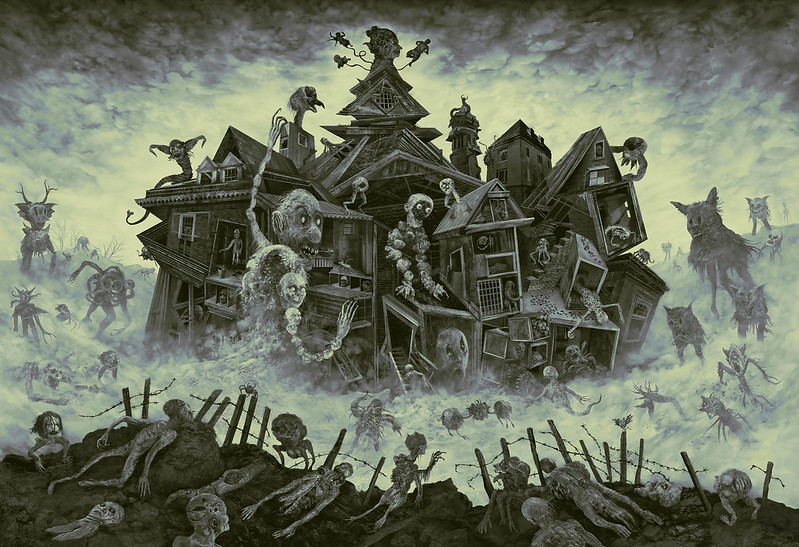 Mad House - Wraparound Cover Art
Mad House - Wraparound Cover Art
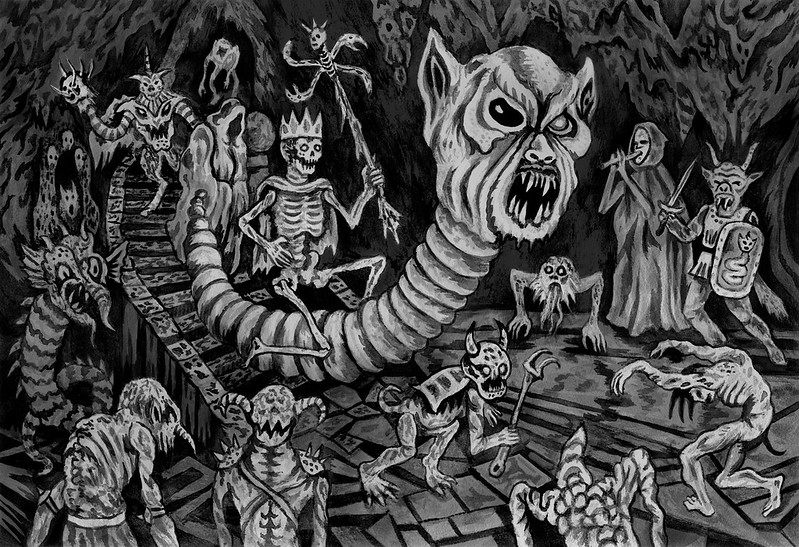 Tomb of the Forgotten King - Interior art for "Cave Evil, War Cults" board game
Tomb of the Forgotten King - Interior art for "Cave Evil, War Cults" board game
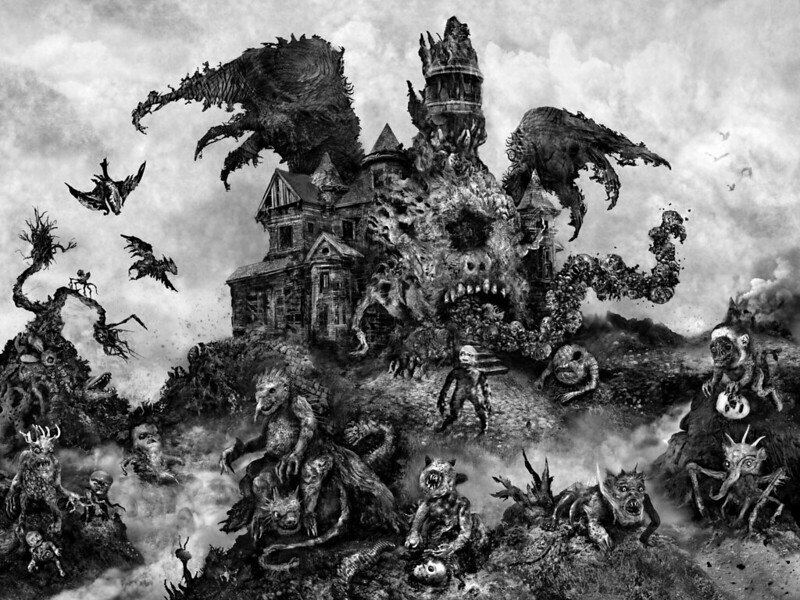 Thomas Ligotti - Grimscribe, Wraparound Cover Art
Thomas Ligotti - Grimscribe, Wraparound Cover Art
 Thomas Ligotti - Songs Of A Dead Dreamer, Wraparound Cover Art
Thomas Ligotti - Songs Of A Dead Dreamer, Wraparound Cover Art
 Invasion of Zanadane, "The Complete Cthulhu Mythos Tales of Michael Shea" Wraparound Cover Artwork
Invasion of Zanadane, "The Complete Cthulhu Mythos Tales of Michael Shea" Wraparound Cover Artwork
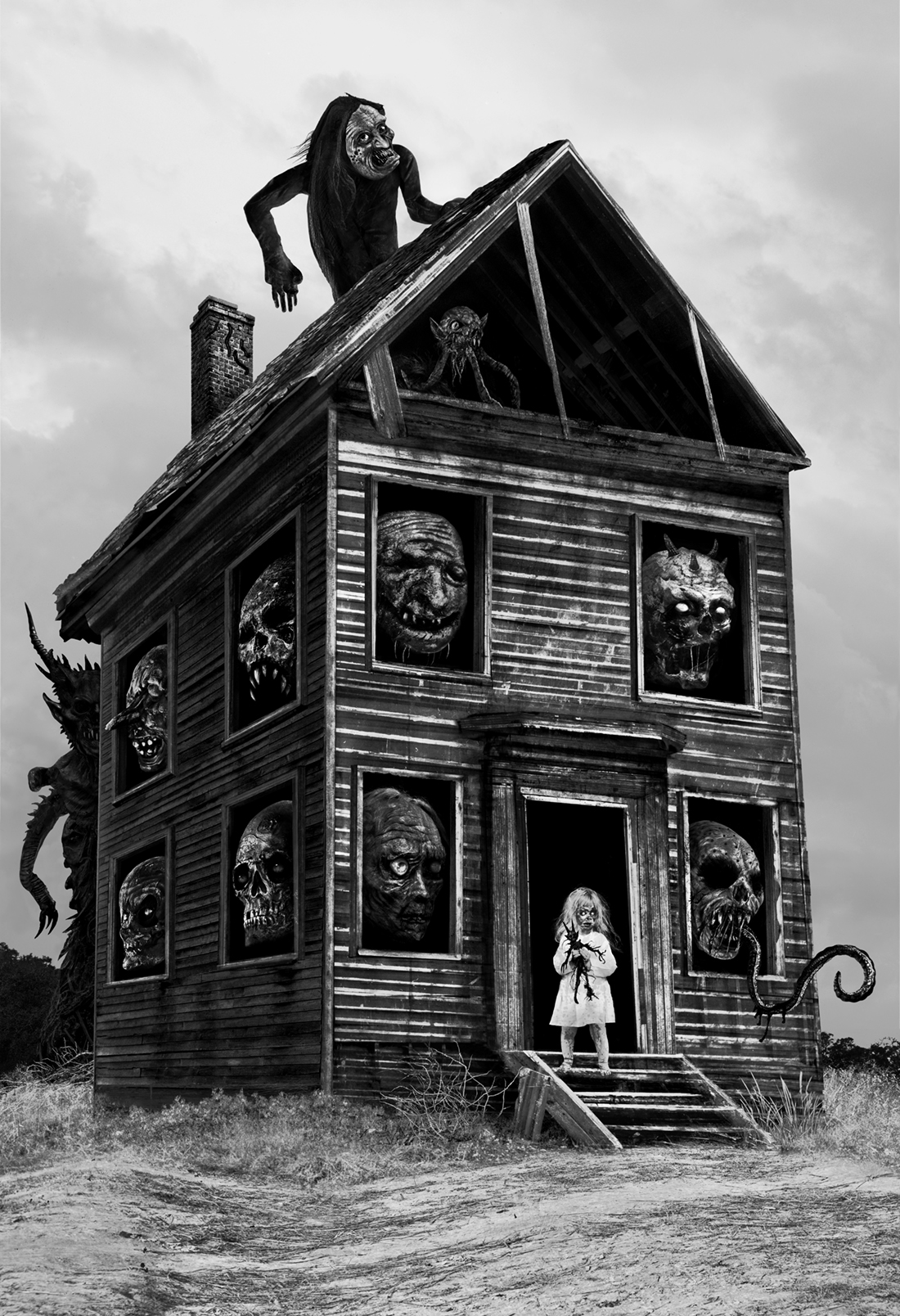 "The Devil's House, Cover art for "Lost Ghosts: The Complete Weird Stories of Mary E. Wilkins Freeman" Cover Art
"The Devil's House, Cover art for "Lost Ghosts: The Complete Weird Stories of Mary E. Wilkins Freeman" Cover Art
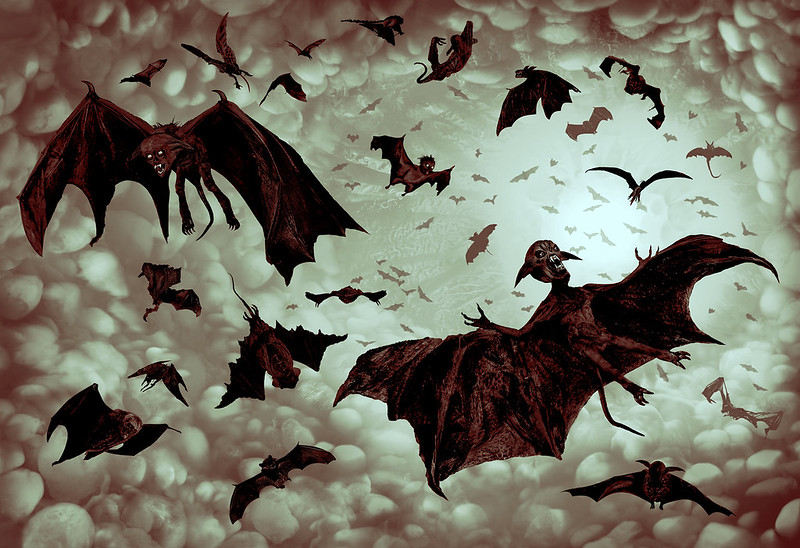 Space Vampires (Inspired by Tobe Hooper's film, Life Force)
Space Vampires (Inspired by Tobe Hooper's film, Life Force)
Starting now through the rest of the week, until midnight on Saturday night, December 4th, I'm offering buy 2 get 1 free on all of my 13x19 inch art prints and smaller. Just mention which third print you want and it will be included with your order.
See all 19 prints available here!
https://aeronalfrey.storenvy.com/collections/1963540-buy-2-get-1-free-print-sale-ends-december-4th
